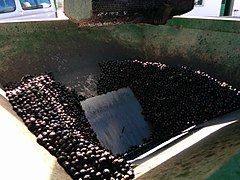Oil press
Almazara (from Arabic المعصرة, al-maʿṣara, "the press") or trujal is a mill designed to crush oilseeds, such as flaxseed or peanuts, or other oil-rich plant material, such as olives, which can then be pressed to extract them, which can be used for food or cooking, as oleochemical raw materials, as lubricants or as biofuels. The pomace or press cake, the remaining solid material, can also be used as food or fertilizer.
Etymology
The heritage word trujal derives from the Latin torculāre to squeeze.
History
Oil-rich plant materials have been mechanically processed to extract the valuable oils for thousands of years, generally using vertical millstones that move around a central post (edge stones or kollergangs) to crush or bruise the oils. seeds or fruits that can then be stamped or pressed to extract the oil. Later a treadmill, windmill or watermill would be used to drive grinding and pressing machinery, replaced in modern times by steam and later by other sources of power. Oxen or horse-powered presses, such as the traditional ghani in Bangladesh, have been increasingly replaced by motor-driven steel presses.
In some areas, watermills may be 'double' watermills, with wheat-grinding machinery on one side of the watercourse and oil-extracting machinery on the other side.
The old wind mills could process between 100 and 200 tons of raw materials per year.
In Roman times, the use of presses (with a lever) for the extraction of oil dates back to the II century a. C. in the regions of Augusto's Italy and in the Italian provinces between the Republic and the Empire. Its installation required an adequate space: characterized by a bulky machinery and a lever that could measure about 10 meters.
Two main types are attested:
- the lever trujal, subdivided into two subtypes;
- trujal cabrestante or "plataform", also known as "model" catoniano" (Cato., Agr., 18).
- the "circular arched" screw trouser, known as the "first plinian model" (Plin., Hist. Nat., XVIII).
- the direct screw trujal, known as the "second plinian model" (Plin., Hist. Nat., XVIII).
In the following centuries, these types of presses would be used throughout the Mediterranean basin and would be progressively replaced by the wood or iron screw press, much more functional and less bulky.
Strujal del trujal
Modern presses are usually made up of three differentiated work spaces according to the production phase, which are:
- Reception patio or area where the olive is received, clean (cleaner), lava (washer), weight (sher) and store, waiting for its grinding, in the so-called lung hoppers. The reception patios are normally open and only one roof is available to protect the olive from the rain.
- Nave of elaboration, constituted by a closed space where the olive is milled (mix of hammers) and the resulting dough is bat (termobatidora), centrifugal (horizontal centrifuge or decanter) and finally cleansed of waters (vertical centrifugal). The oil is then decanted in stainless steel decanters.
- Bodega, enclosed space where the oil is stored in deposits. The deposits, for the good quality of the oil, must be made of stainless steel, easily cleaned and with tilted or conical background for its bleeding or cleaning of funds.
In addition to the above, the trujales have their own facilities for the elimination or storage of by-products or waste such as alperujo hoppers, amurca ponds or alternatively treatment plants. There is also a boiler room to produce heat and they normally feed on olive pomace or olive bone.
Operation
The olive is received in the courtyard of the trujal, where it is deposited in a hopper (formerly, in the barns). From this hopper, it goes to the cleaning line, where dirt (leaves, dirt) is removed. From this line, once weighed, it goes inside the factory to the milling line (crushing). In this process, the olives are ground (grinders), beaten (blenders) and the oil is separated (centrifuges) from the alperujo by density (two-phase system).
The alperujo, which still contains oil, can be reviewed by means of a second centrifugation before sending it to the pomace, where the rest of the oil is extracted using chemical processes (pomace oil is produced).
In some presses, before grinding, the seed is separated from the olive.
Currently, most of the presses use the “continuous system” to grind the olives. This can be of two or three phases, depending on the products obtained: oil and alperujo (two phases, the most currently used) or oil, pomace and amurca (three phases).
Contenido relacionado
Pig
Fideua
Nutriment










